Restoration & 18 thth Century Drama 1660

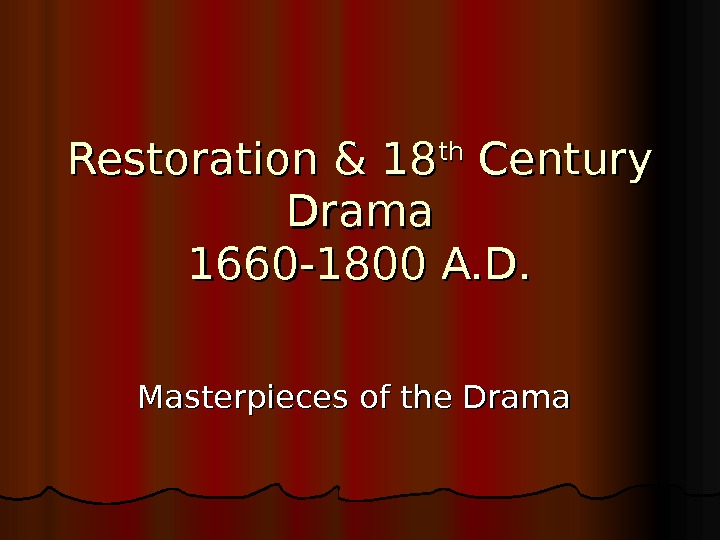








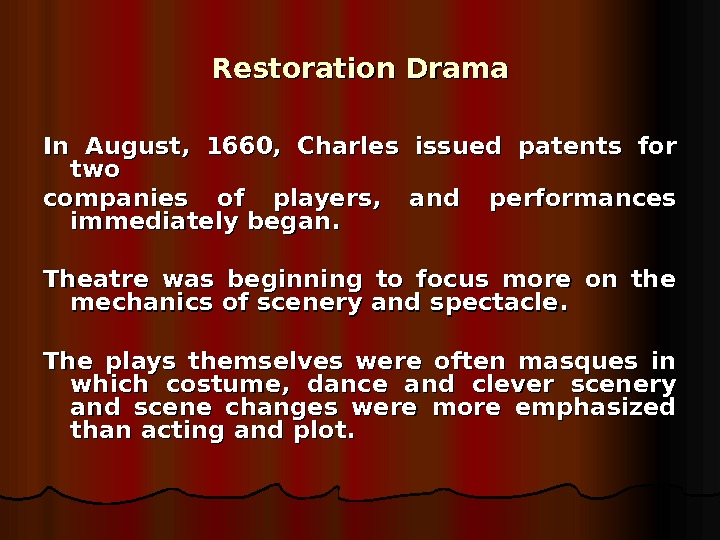







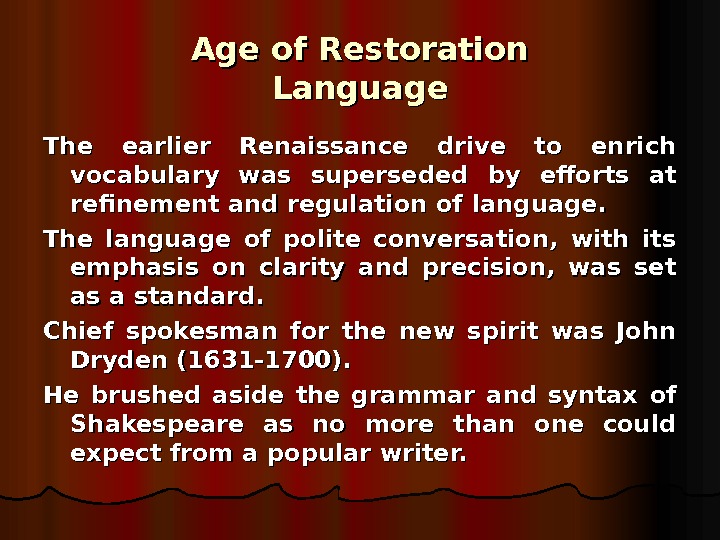



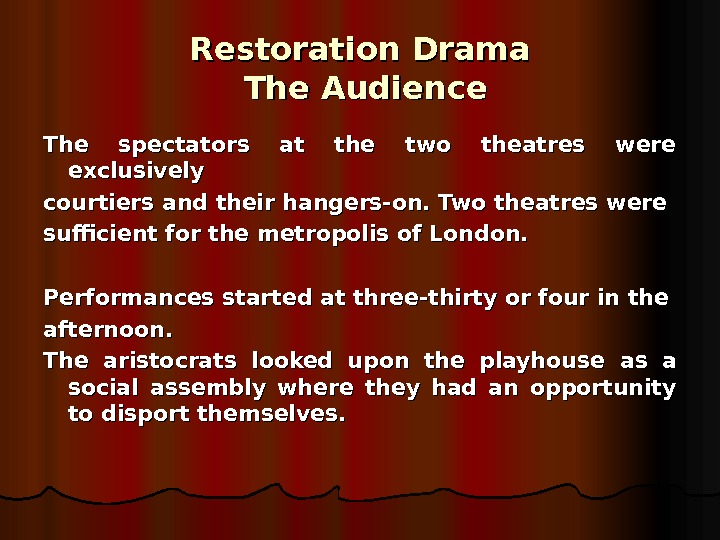



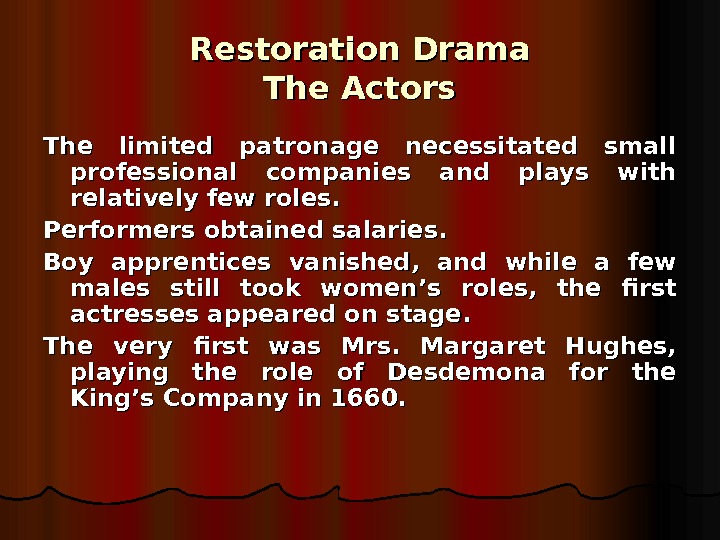
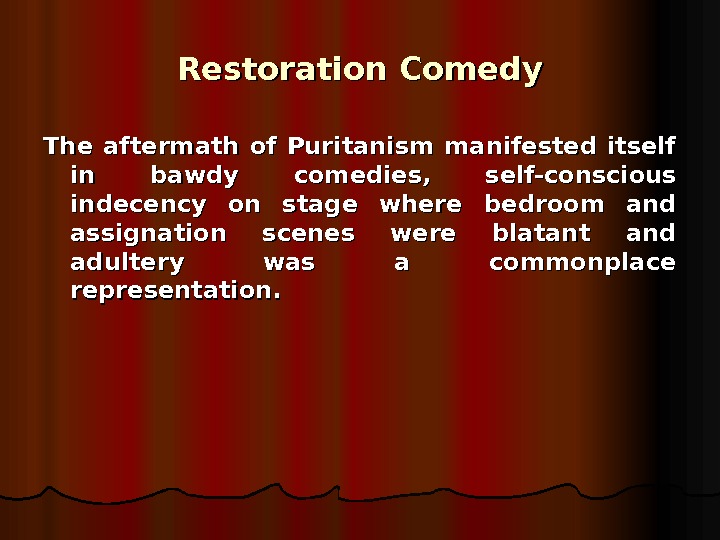

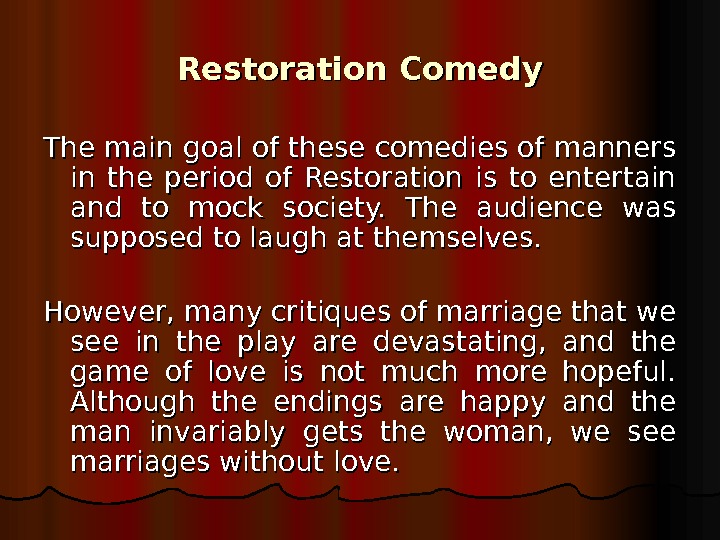







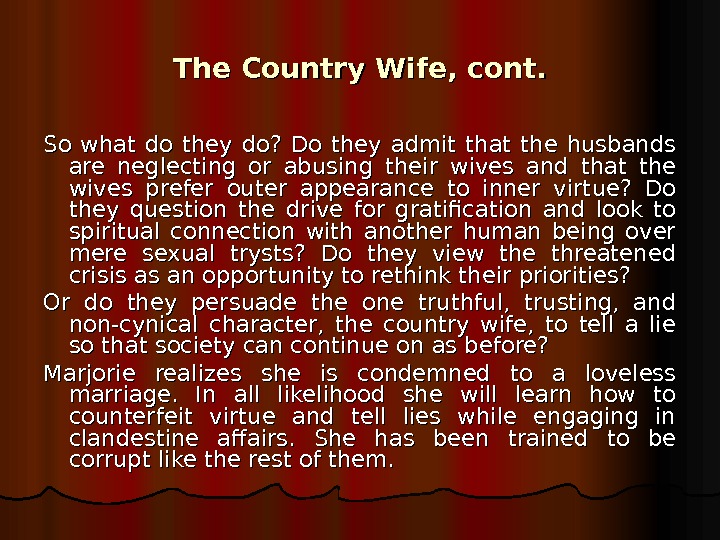













3_restoration_amp_18th_century_drama.ppt
- Размер: 1.5 Mегабайта
- Количество слайдов: 50
Описание презентации Restoration & 18 thth Century Drama 1660 по слайдам
 Restoration & 18 thth Century Drama 1660 -1800 A. D. Masterpieces of the Drama
Restoration & 18 thth Century Drama 1660 -1800 A. D. Masterpieces of the Drama
 Where did we leave off? 1642: Puritans take over the country, and all theatres are closed. 1642 -1660: Interregnum Period 1660: Restoration of the Monarchy
Where did we leave off? 1642: Puritans take over the country, and all theatres are closed. 1642 -1660: Interregnum Period 1660: Restoration of the Monarchy
 Charles II becomes king Response to the puritans Reforms to the theater… English Royal Patent of 1662 — Theater Monopoly Women Actors
Charles II becomes king Response to the puritans Reforms to the theater… English Royal Patent of 1662 — Theater Monopoly Women Actors
 Type of Drama… Coming from an age of Puritanism, what do the people want? Marriage during this time… “Marriage of Convenience. ” Comedy of Manners : reveal the foibles (gyarlóság) of the society that watched them. Society enjoyed laughing at itself. Restoration Comedies: Less interested in reforming society than in capitalizing on its faults.
Type of Drama… Coming from an age of Puritanism, what do the people want? Marriage during this time… “Marriage of Convenience. ” Comedy of Manners : reveal the foibles (gyarlóság) of the society that watched them. Society enjoyed laughing at itself. Restoration Comedies: Less interested in reforming society than in capitalizing on its faults.
 Some of the major players… William Wycherley William Congreve George Farquhar Richard Brinsley Sheridan Oliver Goldsmith
Some of the major players… William Wycherley William Congreve George Farquhar Richard Brinsley Sheridan Oliver Goldsmith
 Richard Brinsley Sheridan Born in Dublin Supposed to study law Settled in London and started writing for public theatre …… Invests his fortune in a share on Drury Lane. The Theater burns down, he drinks wine outside the theater and says, “A “A man may surely be allowed to take a glass of wine by his own fireside. ” Died in Poverty
Richard Brinsley Sheridan Born in Dublin Supposed to study law Settled in London and started writing for public theatre …… Invests his fortune in a share on Drury Lane. The Theater burns down, he drinks wine outside the theater and says, “A “A man may surely be allowed to take a glass of wine by his own fireside. ” Died in Poverty
 The Age of Restoration The term Restoration period is applied to the decades from 1660 (the year Charles II was re-established as monarch) to the end of the century. Between 1660 and 1700, over 500 plays were written in England, more than half of them comedies.
The Age of Restoration The term Restoration period is applied to the decades from 1660 (the year Charles II was re-established as monarch) to the end of the century. Between 1660 and 1700, over 500 plays were written in England, more than half of them comedies.
 The Age of Restoration In 1642, six years before the execution of Charles I in 1649, the Parliament closed the theatres in England. A few years later Oliver Cromwell was proclaimed Lord Protector of the Commonwealth of England, Scotland, and Ireland. His government was fiercely Puritan in religion and in administration. . So until the Restoration of Charles II to the throne in 1660, there was very little of theatre in England.
The Age of Restoration In 1642, six years before the execution of Charles I in 1649, the Parliament closed the theatres in England. A few years later Oliver Cromwell was proclaimed Lord Protector of the Commonwealth of England, Scotland, and Ireland. His government was fiercely Puritan in religion and in administration. . So until the Restoration of Charles II to the throne in 1660, there was very little of theatre in England.
 Restoration Drama However, it was during this time that the influence ofof French theatre, and through it, Italian notions of theatre architecture, was experienced by English actors and royalists in exile. Charles II, the king, had been in France during the greater part of the Protectorate, together wit h h many of the royalist party, all of whom were familiar with Paris and its fashions. Thus it was natural, upon the return of the court, that French influence should be felt, particularly in the theat re.
Restoration Drama However, it was during this time that the influence ofof French theatre, and through it, Italian notions of theatre architecture, was experienced by English actors and royalists in exile. Charles II, the king, had been in France during the greater part of the Protectorate, together wit h h many of the royalist party, all of whom were familiar with Paris and its fashions. Thus it was natural, upon the return of the court, that French influence should be felt, particularly in the theat re.
 Restoration Drama In August, 1660, Charles issued patents for twotwo companies of players, and performances immediately began. Theatre was beginning to focus more on the mechanics of scenery and spectacle. The plays themselves were often masques in which costume, dance and clever scenery and scene changes were more emphasized than acting and plot.
Restoration Drama In August, 1660, Charles issued patents for twotwo companies of players, and performances immediately began. Theatre was beginning to focus more on the mechanics of scenery and spectacle. The plays themselves were often masques in which costume, dance and clever scenery and scene changes were more emphasized than acting and plot.
 Theater Monopolies Two playhouses given official sanction: The King‘s Company Duke of York’s Co. From these two names comes the term, legitimate theater , which refers to professional stage plays.
Theater Monopolies Two playhouses given official sanction: The King‘s Company Duke of York’s Co. From these two names comes the term, legitimate theater , which refers to professional stage plays.
 Women Actors The patent stated: ““ All women’s parts should be performed by women” and that plays and acting should be considered “not only harmless delights but useful and instructive representations of human life. ” Nell Gwynn “moves the passions” First Celebrity Actors
Women Actors The patent stated: ““ All women’s parts should be performed by women” and that plays and acting should be considered “not only harmless delights but useful and instructive representations of human life. ” Nell Gwynn “moves the passions” First Celebrity Actors
 Physical Structure of the Theater Audiences seated on floor Stage is raked , that is, sloped upward away from the viewers. Terms “upstage” and “downstage” develop. Elaborate scenery and mechanical equipment used Move to the indoors, artificial light Middle-priced tickets were in the pit before the proscenium-arched stage. The first-level boxes against the walls were most expensive. The lowest-priced seats were in the upper ranges of the balconies.
Physical Structure of the Theater Audiences seated on floor Stage is raked , that is, sloped upward away from the viewers. Terms “upstage” and “downstage” develop. Elaborate scenery and mechanical equipment used Move to the indoors, artificial light Middle-priced tickets were in the pit before the proscenium-arched stage. The first-level boxes against the walls were most expensive. The lowest-priced seats were in the upper ranges of the balconies.
 Restoration Drama Theatres began to display the proscenium style of architecture, although the forestage remained thethe principal place where the acting took place, and thethe area behind the proscenium was reserved for the display of scenery changes which were slid into view by means of panels on tracks. It was also during this time, when theatre was designed specifically for the royal pleasure, that theatres began to be roofed in.
Restoration Drama Theatres began to display the proscenium style of architecture, although the forestage remained thethe principal place where the acting took place, and thethe area behind the proscenium was reserved for the display of scenery changes which were slid into view by means of panels on tracks. It was also during this time, when theatre was designed specifically for the royal pleasure, that theatres began to be roofed in.
 Restoration Drama It was at the time of the Restoration of the Crown in England, that women first began to appear on stage (a(a convention borrowed from the French), instead of female roles being played by boys and young men. Although theatres were again licensed and controlled by the state , with the dawn of the 18 th Century approaching, it would not be long before the echoes of the Republican period in England and the influence of similar movements abroad would force a broadening ofof theatre’s appeal –– first to property owners andand merchants, and ultimately to the masses.
Restoration Drama It was at the time of the Restoration of the Crown in England, that women first began to appear on stage (a(a convention borrowed from the French), instead of female roles being played by boys and young men. Although theatres were again licensed and controlled by the state , with the dawn of the 18 th Century approaching, it would not be long before the echoes of the Republican period in England and the influence of similar movements abroad would force a broadening ofof theatre’s appeal –– first to property owners andand merchants, and ultimately to the masses.
 Nell Gwynn (1650 -1687), was one of the first actresses (( and the mistress of Charles II )). .
Nell Gwynn (1650 -1687), was one of the first actresses (( and the mistress of Charles II )). .
 Restoration Drama This period also saw thethe first professional woman playwright, Aphra Behn (1640 -1689).
Restoration Drama This period also saw thethe first professional woman playwright, Aphra Behn (1640 -1689).
 Age of Restoration Language The earlier Renaissance drive to enrich vocabulary was superseded by efforts at refinement and regulation of language. The language of polite conversation, with its emphasis on clarity and precision, was set as a standard. Chief spokesman for the new spirit was John Dryden (1631 -1700). . He brushed aside the grammar and syntax o o ff Shakespeare as no more than one could expect f f romrom aa popular writer.
Age of Restoration Language The earlier Renaissance drive to enrich vocabulary was superseded by efforts at refinement and regulation of language. The language of polite conversation, with its emphasis on clarity and precision, was set as a standard. Chief spokesman for the new spirit was John Dryden (1631 -1700). . He brushed aside the grammar and syntax o o ff Shakespeare as no more than one could expect f f romrom aa popular writer.
 Restoration Drama After the Puritan closing of the theatres in 1642 did not mean the absolute disappearance of the English drama. Plays were performed in the private residences of country gentlemen. Some actors attempted public performances surreptitiously. Another and more effect ii ve circumvention of the authorities consisted of drolls, brief excerpts from dramas that could be quickly presented at fairs before a raid could be launched.
Restoration Drama After the Puritan closing of the theatres in 1642 did not mean the absolute disappearance of the English drama. Plays were performed in the private residences of country gentlemen. Some actors attempted public performances surreptitiously. Another and more effect ii ve circumvention of the authorities consisted of drolls, brief excerpts from dramas that could be quickly presented at fairs before a raid could be launched.
 Restoration Drama Yet the theatrical tradition was essentially broken. Most actors of the Caroline stage were dead or out of practice when the Restoration gave the stage a new birth. Upon his resumption of the throne in 1661 Charles II granted two patents, assigning the monopoly of London theatrical performances to the King’s Company, and to the Duke of York’s Company.
Restoration Drama Yet the theatrical tradition was essentially broken. Most actors of the Caroline stage were dead or out of practice when the Restoration gave the stage a new birth. Upon his resumption of the throne in 1661 Charles II granted two patents, assigning the monopoly of London theatrical performances to the King’s Company, and to the Duke of York’s Company.
 Restoration Drama The Audience The Restoration theatre was entirely the court’s preserve. Charles II was the first English monarch who regularly attended the public theatre (even though he had his own private theatre at Whitehall). He personally interested himself in the preparation of scripts and in the running of the acting companies.
Restoration Drama The Audience The Restoration theatre was entirely the court’s preserve. Charles II was the first English monarch who regularly attended the public theatre (even though he had his own private theatre at Whitehall). He personally interested himself in the preparation of scripts and in the running of the acting companies.
 Restoration Drama The Audience The spectators at the two theatres were exclusively courtiers and their hangers-on. Two theatres were sufficient for the metropolis of London. Performances started at three-thirty or four in the afternoon. The aristocrats looked upon the playhouse as a social assembly where they had an opportunity toto disport themselves.
Restoration Drama The Audience The spectators at the two theatres were exclusively courtiers and their hangers-on. Two theatres were sufficient for the metropolis of London. Performances started at three-thirty or four in the afternoon. The aristocrats looked upon the playhouse as a social assembly where they had an opportunity toto disport themselves.
 An Entry from the Diary of Samuel Pepys Monday 18 February 1666/67 Thence away, and with my wife by coach to the Duke of York’s play-house, expecting a new play, and so stayed not no more than other people, but to the King’s house, to “The Mayd’s Tragedy; ” but vexed all the while with two talking ladies and Sir Charles Sedley; yet pleased to hear their discourse, he being a stranger. And one of the ladies would, and did sit with her mask on, all the play, and, being exceeding witty as ever I heard woman, did talk most pleasantly with him; but was, I believe, a virtuous woman, and of quality. He would fain know who she was, but she would not tell;
An Entry from the Diary of Samuel Pepys Monday 18 February 1666/67 Thence away, and with my wife by coach to the Duke of York’s play-house, expecting a new play, and so stayed not no more than other people, but to the King’s house, to “The Mayd’s Tragedy; ” but vexed all the while with two talking ladies and Sir Charles Sedley; yet pleased to hear their discourse, he being a stranger. And one of the ladies would, and did sit with her mask on, all the play, and, being exceeding witty as ever I heard woman, did talk most pleasantly with him; but was, I believe, a virtuous woman, and of quality. He would fain know who she was, but she would not tell;
 Pepys, cont. yet did give him many pleasant hints of her knowledge of him, by that means setting his brains at work to find out who she was, and did give him leave to use all means to find out who she was, but pulling off her mask. He was mighty witty, and she also making sport with him very inoffensively, that a more pleasant ‘rencontre’ I never heard. But by that means lost the pleasure of the play wholly, to which now and then Sir Charles Sedley’s exceptions against both words and pronouncing were very pretty. So home and to the office, did much business, then home, to supper, and to bed.
Pepys, cont. yet did give him many pleasant hints of her knowledge of him, by that means setting his brains at work to find out who she was, and did give him leave to use all means to find out who she was, but pulling off her mask. He was mighty witty, and she also making sport with him very inoffensively, that a more pleasant ‘rencontre’ I never heard. But by that means lost the pleasure of the play wholly, to which now and then Sir Charles Sedley’s exceptions against both words and pronouncing were very pretty. So home and to the office, did much business, then home, to supper, and to bed.
 Restoration Drama Theatre William Davenant, head of the Duke of York’s Company, abandoned the Renaiss anan ce ce English stage in favour of the French one. The theatres were indoors. The forestage still projected into the audience but was significantly cut. The curtain was Davenant’s innovation. He also introduced painted backdrops. Gallants were seldom permitted on the stage, yet were on display in boxes set on either side of the forestag e e (apron).
Restoration Drama Theatre William Davenant, head of the Duke of York’s Company, abandoned the Renaiss anan ce ce English stage in favour of the French one. The theatres were indoors. The forestage still projected into the audience but was significantly cut. The curtain was Davenant’s innovation. He also introduced painted backdrops. Gallants were seldom permitted on the stage, yet were on display in boxes set on either side of the forestag e e (apron).
 Restoration Drama The Actors The limited patronage necessitated small professional companies and plays with relatively few roles. Performers obtained salaries. Boy apprentices vanished, and while a few males still took women’s roles, the first actresses appeared on stage. The very first was Mrs. Margaret Hughes, playing the role of Desdemona for the King’s Company in 1660.
Restoration Drama The Actors The limited patronage necessitated small professional companies and plays with relatively few roles. Performers obtained salaries. Boy apprentices vanished, and while a few males still took women’s roles, the first actresses appeared on stage. The very first was Mrs. Margaret Hughes, playing the role of Desdemona for the King’s Company in 1660.
 Restoration Comedy The aftermath of Puritanism manifested itself in bawdy comedies, self-conscious indecency on stage where bedroom and assignation scenes were blatant and adultery was a commonplace representation.
Restoration Comedy The aftermath of Puritanism manifested itself in bawdy comedies, self-conscious indecency on stage where bedroom and assignation scenes were blatant and adultery was a commonplace representation.
 Restoration Comedy The kind of drama which prevailed during the Age of Rest oo ration, often referred to as comedy of manners, chiefly concerned with presenting a society of elegance and stylishness. Its characters were gallants, ladies and gentlemen of fashion and ranks, fops (piperkőc) , rakes, social climbers and country bumpkins (bugris). . The tone was witty, urbane, licentious (kicsapongó). . The plot dealt with the intricacies of sexual and marital intrigue, adultery.
Restoration Comedy The kind of drama which prevailed during the Age of Rest oo ration, often referred to as comedy of manners, chiefly concerned with presenting a society of elegance and stylishness. Its characters were gallants, ladies and gentlemen of fashion and ranks, fops (piperkőc) , rakes, social climbers and country bumpkins (bugris). . The tone was witty, urbane, licentious (kicsapongó). . The plot dealt with the intricacies of sexual and marital intrigue, adultery.
 Restoration Comedy The main goal of these comedies of manners in the period of Restoration is to entertain and to mock society. The audience was supposed to laugh at themselves. However, many critiques of marriage that we see in the play are devastating, and the game of love is not much more hopeful. Although the endings are happy and the man invariably gets the woman, we see marriages without love.
Restoration Comedy The main goal of these comedies of manners in the period of Restoration is to entertain and to mock society. The audience was supposed to laugh at themselves. However, many critiques of marriage that we see in the play are devastating, and the game of love is not much more hopeful. Although the endings are happy and the man invariably gets the woman, we see marriages without love.
 Restoration Comedy Typically, one of the major themes of restoration comedy is marriage and the game of love. The plot would involve a dashing (lendületes) , witty hero trying to have sex with as many women as possible without getting into trouble, with funny consequences. Restoration comedies include bawdy humour, witty dialogues, recursive cross-dressing.
Restoration Comedy Typically, one of the major themes of restoration comedy is marriage and the game of love. The plot would involve a dashing (lendületes) , witty hero trying to have sex with as many women as possible without getting into trouble, with funny consequences. Restoration comedies include bawdy humour, witty dialogues, recursive cross-dressing.
 Restoration Comedy Women were allowed to perform on stage for the first time, and the mostly male audiences were attracted by the idea of seeing women acting out ss eduction scenes and the possibility of seeing a bit of shapely leg on stage. Clothes were often several sizes too small so as to emphasize the curves of their bodies.
Restoration Comedy Women were allowed to perform on stage for the first time, and the mostly male audiences were attracted by the idea of seeing women acting out ss eduction scenes and the possibility of seeing a bit of shapely leg on stage. Clothes were often several sizes too small so as to emphasize the curves of their bodies.
 Restoration Comedy Chief representatives and plays: William Wycherley: The Country Wife (1672 or 1673); The Plain Dealer (1674) George Etheredge: The Man of Mode (1676) William Congreve: The Double Dealer (1694); Love for Love (11695); The Way of the World (1700) John Vanbrugh: The Provoked Wife (1697) George Farquhar: The Beaux’ Strategem (1707) Thomas Shadwell: The Libertine (1676), The Volunteers, or Stockjobbers (1693)
Restoration Comedy Chief representatives and plays: William Wycherley: The Country Wife (1672 or 1673); The Plain Dealer (1674) George Etheredge: The Man of Mode (1676) William Congreve: The Double Dealer (1694); Love for Love (11695); The Way of the World (1700) John Vanbrugh: The Provoked Wife (1697) George Farquhar: The Beaux’ Strategem (1707) Thomas Shadwell: The Libertine (1676), The Volunteers, or Stockjobbers (1693)
 Comedy of Manners A genre which has for its main subjects and themes the behaviour and deportment of people living under specific social codes. It is preoccupied with the codes of the middle and upper classes and is often marked by elegance, wit and sophistication. Restoration comedies provide outstanding instances. Later examples of the genre are Oscar Wilde’s The Importance of Being Ernest (1895) or No ëë l l Coward’s Private Lives (1930).
Comedy of Manners A genre which has for its main subjects and themes the behaviour and deportment of people living under specific social codes. It is preoccupied with the codes of the middle and upper classes and is often marked by elegance, wit and sophistication. Restoration comedies provide outstanding instances. Later examples of the genre are Oscar Wilde’s The Importance of Being Ernest (1895) or No ëë l l Coward’s Private Lives (1930).
 William Wycherley (1640 -1706)
William Wycherley (1640 -1706)
 The Country Wife https: //www. youtube. com/watch? v=YIJXa. Bflc 30 In Wycherley’s play, the one person who wants to tell the truth is pressured to be silent so that the society can continue to teeter along. Here’s the plot. The lead character is Horner, a predatory rake who wants to cuckold as many husbands as he can. Because the husbands are so leery (furfangos) of of him, however, he has a doctor (Quack) leak the news that he has been rendered impotent by venereal disease. Since he is now “safe, ” Sir Jasper Fidget wants Horner to chaperone his wife as he goes about his business. Horner more than obliges. http: //youtu. be/ROI 9 Fh. R 6 URI
The Country Wife https: //www. youtube. com/watch? v=YIJXa. Bflc 30 In Wycherley’s play, the one person who wants to tell the truth is pressured to be silent so that the society can continue to teeter along. Here’s the plot. The lead character is Horner, a predatory rake who wants to cuckold as many husbands as he can. Because the husbands are so leery (furfangos) of of him, however, he has a doctor (Quack) leak the news that he has been rendered impotent by venereal disease. Since he is now “safe, ” Sir Jasper Fidget wants Horner to chaperone his wife as he goes about his business. Horner more than obliges. http: //youtu. be/ROI 9 Fh. R 6 URI
 The Country Wife, cont. But Horner also has an affair with Marjorie Pinchwife, the country wife of the title, who is innocent to the ways of the city and who believes that two people who love each other should be together. She likes Horner much better than her jealous husband and is prepared, in a burst of sincerity, to publicly declare Horner her lover and leave her husband for him. In doing so, of course, she would reveal that he has been faking his disease. Suddenly, the whole society is in danger of imploding. Sir Jasper will be revealed to have been a cuckold, as will Pinchwife. Their wives, meanwhile, will lose their “honor, ” as will all the other women that Horner has been “chaperoning. ”
The Country Wife, cont. But Horner also has an affair with Marjorie Pinchwife, the country wife of the title, who is innocent to the ways of the city and who believes that two people who love each other should be together. She likes Horner much better than her jealous husband and is prepared, in a burst of sincerity, to publicly declare Horner her lover and leave her husband for him. In doing so, of course, she would reveal that he has been faking his disease. Suddenly, the whole society is in danger of imploding. Sir Jasper will be revealed to have been a cuckold, as will Pinchwife. Their wives, meanwhile, will lose their “honor, ” as will all the other women that Horner has been “chaperoning. ”
 The Country Wife, cont. So what do they do? Do they admit that the husbands are neglecting or abusing their wives and that the wives prefer outer appearance to inner virtue? Do they question the drive for gratification and look to spiritual connection with another human being over mere sexual trysts? Do they view the threatened crisis as an opportunity to rethink their priorities? Or do they persuade the one truthful, trusting, and non-cynical character, the country wife, to tell a lie so that society can continue on as before? Marjorie realizes she is condemned to a loveless marriage. In all likelihood she will learn how to counterfeit virtue and tell lies while engaging in clandestine affairs. She has been trained to be corrupt like the rest of them.
The Country Wife, cont. So what do they do? Do they admit that the husbands are neglecting or abusing their wives and that the wives prefer outer appearance to inner virtue? Do they question the drive for gratification and look to spiritual connection with another human being over mere sexual trysts? Do they view the threatened crisis as an opportunity to rethink their priorities? Or do they persuade the one truthful, trusting, and non-cynical character, the country wife, to tell a lie so that society can continue on as before? Marjorie realizes she is condemned to a loveless marriage. In all likelihood she will learn how to counterfeit virtue and tell lies while engaging in clandestine affairs. She has been trained to be corrupt like the rest of them.
 William Congreve (1670 -1729)
William Congreve (1670 -1729)
 The Way of the World The play is based around the two lovers Mirabell and Millamant. In order for the two to get married and receive Millamant’s full dowry, Mirabell must receive the blessing of Millamant’s aunt, Lady Wishfort. Unfortunately, she is a bitter lady, who despises Mirabell and wants her own nephew, Sir Wilful, to wed Millamant. Mirabell and Millamant, equally strong-willed, discuss in detail the conditions under which they would accept each other in marriage (otherwise known as the «proviso scene»), showing the depth of feeling for each other. Mirabell finally proposes to Millamant and Millamant accepts.
The Way of the World The play is based around the two lovers Mirabell and Millamant. In order for the two to get married and receive Millamant’s full dowry, Mirabell must receive the blessing of Millamant’s aunt, Lady Wishfort. Unfortunately, she is a bitter lady, who despises Mirabell and wants her own nephew, Sir Wilful, to wed Millamant. Mirabell and Millamant, equally strong-willed, discuss in detail the conditions under which they would accept each other in marriage (otherwise known as the «proviso scene»), showing the depth of feeling for each other. Mirabell finally proposes to Millamant and Millamant accepts.
 The Way of the World, cont. The love expressed in the play tends to be centred on material gain rather than the love of the partner. This can be seen in the scene where Millamant and Mirabell effectively carry out a pre-nuptial agreement, Millamant insisting on having all manner of liberties and powers, quite unusual for the time. None of the characters in the play can really be seen as ‘good’, and as such it is difficult to find a hero or heroine, or indeed anybody whom one would find deserving of sympathy.
The Way of the World, cont. The love expressed in the play tends to be centred on material gain rather than the love of the partner. This can be seen in the scene where Millamant and Mirabell effectively carry out a pre-nuptial agreement, Millamant insisting on having all manner of liberties and powers, quite unusual for the time. None of the characters in the play can really be seen as ‘good’, and as such it is difficult to find a hero or heroine, or indeed anybody whom one would find deserving of sympathy.
 William Congreve : : The Way of the World ACT IV. – SCENE V. MRS. MILLAMANT, MIRABELL. MILLA. […] My dear liberty, shall I leave thee? My faithful solitude, my darling contemplation, must I bid you then adieu? Ay-h, adieu. My morning thoughts, agreeable wakings, indolent slumbers, all ye DOUCEURS, ye SOMMEILS DU MATIN, adieu. I can’t do’t, ’tis more than impossible—positively, Mirabell, I’ll lie a-bed in a morning as long as I please. MI RA. Then I’ll get up in a morning as early as I please. MILLA. Ah! Idle creature, get up when you will. And d’ye hear, I won’t be called names after I’m married; positively I won’t be called names. MIRA. Names?
William Congreve : : The Way of the World ACT IV. – SCENE V. MRS. MILLAMANT, MIRABELL. MILLA. […] My dear liberty, shall I leave thee? My faithful solitude, my darling contemplation, must I bid you then adieu? Ay-h, adieu. My morning thoughts, agreeable wakings, indolent slumbers, all ye DOUCEURS, ye SOMMEILS DU MATIN, adieu. I can’t do’t, ’tis more than impossible—positively, Mirabell, I’ll lie a-bed in a morning as long as I please. MI RA. Then I’ll get up in a morning as early as I please. MILLA. Ah! Idle creature, get up when you will. And d’ye hear, I won’t be called names after I’m married; positively I won’t be called names. MIRA. Names?
 The Wa yy of the World, cont. MILLA. Ay, as wife, spouse, my dear, joy, jewel, love, sweet-heart, and the rest of that nauseous cant, in which men and their wives are so fulsomely familiar —I shall never bear that. Good Mirabell, don’t let us be familiar or fond, nor kiss before folks, like my Lady Fadler and Sir Francis; nor go to Hyde Park together the first Sunday in a new chariot, to provoke eyes and whispers, and then never be seen there together again, as if we were proud of one another the first week, and ashamed of one another ever after. Let us never visit together, nor go to a play together, but let us be very strange and well-bred. Let us be as strange as if we had been married a great while, and as well-bred as if we were not married at all.
The Wa yy of the World, cont. MILLA. Ay, as wife, spouse, my dear, joy, jewel, love, sweet-heart, and the rest of that nauseous cant, in which men and their wives are so fulsomely familiar —I shall never bear that. Good Mirabell, don’t let us be familiar or fond, nor kiss before folks, like my Lady Fadler and Sir Francis; nor go to Hyde Park together the first Sunday in a new chariot, to provoke eyes and whispers, and then never be seen there together again, as if we were proud of one another the first week, and ashamed of one another ever after. Let us never visit together, nor go to a play together, but let us be very strange and well-bred. Let us be as strange as if we had been married a great while, and as well-bred as if we were not married at all.
 The Wa yy of the World, cont. MIRA. Have you any more conditions to offer? Hitherto your demands are pretty reasonable. MILLA. Trifles; as liberty to pay and receive visits to and from whom I please; to write and receive letters, without interrogatories or wry faces on your part; to wear what I please, and choose conversation with regard only to my own taste; to have no obligation upon me to converse with wits that I don’t like, because they are your acquaintance, or to be intimate with fools, because they may be your relations. Come to dinner when I please, dine in my dressing- room when I’m out of humour, without giving a reason. To have my closet inviolate; to be sole empress of my tea-table, which you must never presume to approach without first asking leave. And lastly, wherever I am, you shall always knock at the door before you come in. These articles subscribed, if I continue to endure you a little longer, I may by degrees dwindle into a wife.
The Wa yy of the World, cont. MIRA. Have you any more conditions to offer? Hitherto your demands are pretty reasonable. MILLA. Trifles; as liberty to pay and receive visits to and from whom I please; to write and receive letters, without interrogatories or wry faces on your part; to wear what I please, and choose conversation with regard only to my own taste; to have no obligation upon me to converse with wits that I don’t like, because they are your acquaintance, or to be intimate with fools, because they may be your relations. Come to dinner when I please, dine in my dressing- room when I’m out of humour, without giving a reason. To have my closet inviolate; to be sole empress of my tea-table, which you must never presume to approach without first asking leave. And lastly, wherever I am, you shall always knock at the door before you come in. These articles subscribed, if I continue to endure you a little longer, I may by degrees dwindle into a wife.
![The Wa yy of the World, cont. [[ …… ]] MIRA. Then we're agreed. Shall I The Wa yy of the World, cont. [[ …… ]] MIRA. Then we're agreed. Shall I](/docs//3_restoration_amp_18th_century_drama_images/3_restoration_amp_18th_century_drama_43.jpg) The Wa yy of the World, cont. [[ …… ]] MIRA. Then we’re agreed. Shall I kiss your hand upon the contract?
The Wa yy of the World, cont. [[ …… ]] MIRA. Then we’re agreed. Shall I kiss your hand upon the contract?
 Heroic Drama A form of tragedy which was fashionable at the beginning of the Restoration period. Its themes were love and honour, its mode grand, rhetorical and declamatory, at its worst bombastic. The chief influence was French classical drama, especially the works of Pierre Corneille (1616 -1684). It was staged in a spectacular and operatic fashion. John Dryden’s The Indian Queen (1664), The Indian Emperor (1665) and All for Love (based on Shakespeare’s Antony and Cleopatra ) are good examples.
Heroic Drama A form of tragedy which was fashionable at the beginning of the Restoration period. Its themes were love and honour, its mode grand, rhetorical and declamatory, at its worst bombastic. The chief influence was French classical drama, especially the works of Pierre Corneille (1616 -1684). It was staged in a spectacular and operatic fashion. John Dryden’s The Indian Queen (1664), The Indian Emperor (1665) and All for Love (based on Shakespeare’s Antony and Cleopatra ) are good examples.
 Sentimental Comedy The Age of Neoclassicism Also known as the drama of sensibility, it followed onon from Restoration comedy and was a kind of reaction against what was regarded as immorality and licence in the latter. As Oliver Goldsmith put it, in it ““ the virtues of private life a rr e exhibited, rather than the vices exposed, andand the distresses rather than the frail tt y of mankind. ”
Sentimental Comedy The Age of Neoclassicism Also known as the drama of sensibility, it followed onon from Restoration comedy and was a kind of reaction against what was regarded as immorality and licence in the latter. As Oliver Goldsmith put it, in it ““ the virtues of private life a rr e exhibited, rather than the vices exposed, andand the distresses rather than the frail tt y of mankind. ”
 Sentimental Comedy The characters, both good and bad, were luminously simple. A chief instance is Oliver Goldsmith’s The Good Natured Man (1768) and She Stoops to Conquer, or The Mistakes of a Night (1773). . Goldsmith, however mocks sentimental comedy continually, revealing sensiblity as hypocrisy.
Sentimental Comedy The characters, both good and bad, were luminously simple. A chief instance is Oliver Goldsmith’s The Good Natured Man (1768) and She Stoops to Conquer, or The Mistakes of a Night (1773). . Goldsmith, however mocks sentimental comedy continually, revealing sensiblity as hypocrisy.
 Another exponent of neoclassicist comedy of manners waswas Richard Brinsley Butler Sheridan (1751– 1816), an Irish-born playwright and poet and long-term owner of thethe London Theatre Royal, Drury Lane. His masterpiece is The School for Scandal (1777) in which he attacks sentimentalism and criticizes frivolous and fraudulent London high society.
Another exponent of neoclassicist comedy of manners waswas Richard Brinsley Butler Sheridan (1751– 1816), an Irish-born playwright and poet and long-term owner of thethe London Theatre Royal, Drury Lane. His masterpiece is The School for Scandal (1777) in which he attacks sentimentalism and criticizes frivolous and fraudulent London high society.
 Romanticism (mainly in German theatre): need for historical consistency (no precision, though) for imaginative & plausible presentation (realism) mid-19 th c. France: return to the tradition of middle class dramas good acting: move with the natural elegance of gentry touring companies disappear
Romanticism (mainly in German theatre): need for historical consistency (no precision, though) for imaginative & plausible presentation (realism) mid-19 th c. France: return to the tradition of middle class dramas good acting: move with the natural elegance of gentry touring companies disappear
 New Historicism Interrogate the relationship between history and literature – especially concerning the Renaissance and Romantic period
New Historicism Interrogate the relationship between history and literature – especially concerning the Renaissance and Romantic period

